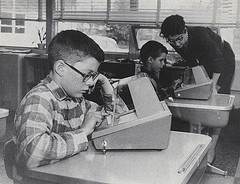May 20, 2009 Comments Off on “Don’t Just Take Any Job You Get” and Other Tips on Running Your Own Design Studio
“Don’t Just Take Any Job You Get” and Other Tips on Running Your Own Design Studio
In 2007, I interviewed Minh Nguyen who was working through Aquent’s San Diego office. He had built his own web design studio from scratch and was kind enough to share with me lessons he had learned along the way.
 Minh Nguyen, a Southern California-based web designer currently working for Sony Electronics, has been represented by our San Diego office for a little over a year.
Minh Nguyen, a Southern California-based web designer currently working for Sony Electronics, has been represented by our San Diego office for a little over a year.
Interestingly enough, his entrance into the Aquent world was fairly coincidental. “A friend of mine was looking for work and I told them about Aquent,” he tells me. “I was walking them through the application process by setting up a profile of my own. I didn’t think much about it but pretty soon someone from Aquent contacted me.”
Minh got into graphic design at an early age. As he puts it, “I owe it to my family. My grandfather taught me how to draw when I was 3. My mom taught me how to color inside the lines when I was 5. My dad taught me HTML and introduced me to Photoshop when I was 14.” He was doing web-design casually as a teenager, but by the time he got into college realized he had a passion for it.
Having a hard time getting a full-time design job after graduation, he started his own studio with some friends. Although the studio did fairly well – garnering clients from Jack in the Box to the Surf Rider Foundation – he decided that he was more interested in doing design work than running a business. He turned to Aquent to get back into design and eventually found a permanent position through us.
Since running one’s own studio is a choice that many designers make and even more consider, I asked Minh what he learned from his experience doing so. Here’s what he told me:
1. Don’t just take any job you get, do things for free, or do things on the cheap.
Not only does this lower the bar for other people working in the field, the sites usually aren’t that great, and the client will ultimately be dissatisfied.
2. Try to maintain control with clients.
In my first meeting, I am very clear about what I’m going to do, what it’s going to cost, and the timeline I’ll be following. If there are any changes to the timeline or the scope of the project, I have to approve them. If during the course of the work I think that the timeline isn’t going to work, I address it immediately. You need to speak up and restructure things when it’s not working out. Finally, if the client is giving you a timeline that’s too tight, don’t be afraid to ask for more time. Chances are, other things will come up in your life making that deadline even more impossible to meet.
3. No matter how badly you want a client, if they give you a bad gut feeling, its best not to work with them.
Good money is important. but if they keep you up at night and you find yourself utterly aggravated working with them it’s just not worth it. If the client is too focused on the money, that’s a red flag – they’ll jump ship the moment they can find a better deal. Likewise, if a prospective client tells you he/she has had 4 designers quit while on the job, watch out. Don’t let yourself become the 5th to bail.
4. Plan out your pricing.
You need to consider what you need to make. It’s not just about your time and the materials. When you’re running your own business, you have overhead, taxes, benefits, etc. you have to pay for. That needs to be factored in. If you don’t think about the real cost of doing business, and keep and eye on your margins, you won’t have any.
Coda: The Talent Bridge
As it turns out, Aquent placed Minh at his current position through our “Talent Bridge” program, whereby people can try out a job before ultimately committing to it. When I asked Minh if he would recommend that arrangement for others, here’s what he said:
“I would definitely recommend Aquent, or something similar, for other designers seeking permanent or temporary work. For me, they’ve always been fast, reliable and compliant to my needs. When I needed a job, Aquent would find multiple openings tailored to fit what I wanted. They matched or exceeded my pay scale every time and only sent me on jobs that I felt comfortable doing. I tried finding my own work on Monster and other job sites and it was nearly impossible for me to find the kind of tailored fit they were finding for me. It would take me a whole week to find 2 decent job openings while Aquent was calling back every day with 2 or 3 options.
“Another reason I would recommend Aquent is because they’re great for designers who’ve had a few years of experience at one design firm and want to move on and explore their options. Through Aquent I got the chance to go from one company to the next, small, medium and large. It allowed me to find and gauge what I was looking for in a long-term job. Without you guys, I think it would have taken a couple of years to do all that. Instead I did it all in less then one.
“As a designer, working for myself I didn’t really have much experience negotiating with HR or even knowing how to get a fair chance at an interview. I loved how Aquent took care of that for me. All I had to do was show my work at the interview and it was a done deal. Its nice having a team of agents negotiating my every need.”
And, frankly, it’s a privilege to work with folks like Minh.
Image courtesy of Minh Nguyen.







